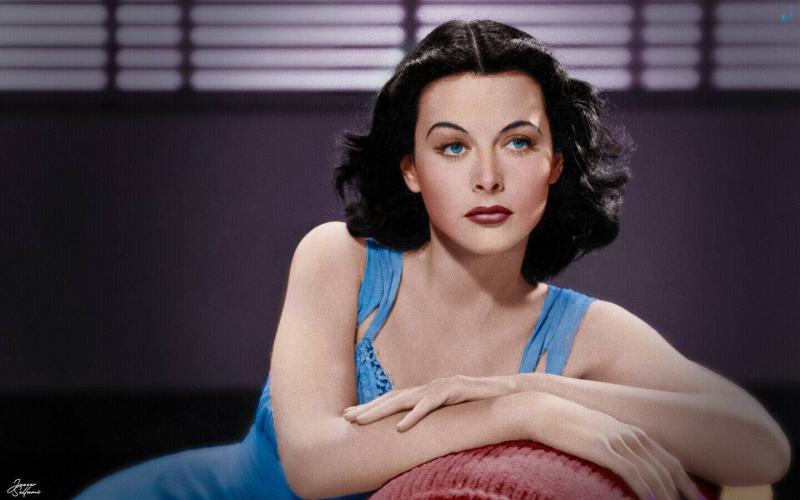Today, Google celebrates the birthday of American star "Hedwig Eva Maria Kiesler," known as Hedy Lamarr, the Hollywood beauty and Austrian-American inventor and mathematician. She gained fame for her enchanting beauty, which served as her ticket into the Hollywood film industry during its golden age. However, alongside her beautiful face and strong feminine presence, Lamarr possessed a sharp intellect and innovative ability that led her to invent technology still used today in many modern scientific applications. What is the story of Lamarr, who fled Europe to become a shining movie star in America and tried to change the course of World War II with her inventions, but was not taken seriously due to her beauty, fame, and perhaps simply because she was a woman?
**Early Life**
Hedwig Eva Maria Kiesler was born in Vienna, Austria-Hungary, the only child of a wealthy family. She gained fame before moving to Hollywood through her role in the 1949 film "Samson and Delilah." After that, the Hollywood star transitioned into the field of scientific research. Some scientists believe that she is the true inventor of the mobile phone and that she registered her invention in America, along with another invention for "wireless torpedo guidance." She conceived the idea of torpedo control while married to a man who sold arms, having been married six times.
Lamarr received acting lessons in Vienna and participated in minor roles in films and plays in Austria and Germany during her teenage years. However, her leading role in the film "Ecstasy" (Ecstase in Czech and Ekstase in German), directed by Czech Gustav Machaty when she was eighteen, earned her international fame and also garnered a scandalous reputation. The film was considered an artistic work in most European countries and won an award at the Venice Film Festival. However, it was condemned by the Vatican and faced negative reactions in the United States due to Lamarr appearing nude in some scenes and her face being featured in a sexually suggestive scene.
**Lamarr the Inventor**
Lamarr found solace in her favorite hobby, inventing, which she engaged in after her work at the studio. She became acquainted with aircraft designer Howard Hughes, and a romantic relationship developed between them, united by their shared love for science and inventions. Lamarr admired Hughes's intellect and often visited his factory to see how planes are designed and built. In a 1990 interview, Lamarr mentioned that Hughes was trying to increase the speed of his planes during that time, and she helped him by suggesting a change in wing design after studying pictures of bird wings and fish fins known for their speed.
In her free time, Lamarr invented several things, including a tablet that dissolves in water to create a carbonated drink, but her invention was unsuccessful due to the poor taste of the drink, as Lamarr herself admitted.
In the early 1940s, the Axis powers were making significant advances on multiple fronts, and Britain, with its conventional weapons, was struggling to counter advanced German weaponry. Naval vessels needed to control ship and submarine-targeting torpedoes and change their course when necessary, making communication between the vessels and those torpedoes essential. However, wireless communication was not secure, as the enemy could track and jam its frequency.
Lamarr conceived the idea of inventing a secret communication method that couldn't be jammed: instead of using a single frequency, she proposed using multiple frequencies that changed constantly in synchronization, making them impossible to jam. Lamarr stated in a 1990 interview, "The idea for this invention came to me when I was thinking of creating something that could help maintain some balance for Britain."
Not knowing how to implement her genius idea, Lamarr sought the help of an innovative composer named George Antheil. While Antheil was not an engineer, he was an expert on how piano devices work and how to tune them. He suggested using two small cylinders resembling piano playback rolls, which would start rotating together at the same frequency to produce something akin to a secret code that would allow ships to communicate with torpedoes.
The two presented the idea to the American National Inventors Council, which deemed it brilliant and advised them to contact Professor Sam MacKowan, who designed the electronic component for the invention. The patent was registered in the name of Hedwig Kiesler Markey (Lamarr's name during her second marriage to screenwriter Gene Markey) and George Antheil in 1942.
The documentary "Bombshell: The Hedy Lamarr Story," released in late 2017, indicates that Lamarr and Antheil donated their invention to the National Inventors Council, which in turn gave it to the U.S. Navy. The film recounts Antheil stating that the Navy rejected the invention and mocked the idea of putting piano rolls on torpedoes. The film also notes that Lamarr wanted to continue developing the invention after the Navy rejected it, but Antheil lost enthusiasm.
**Death**
Lamarr passed away in Florida on January 19, 2000, at the age of 86. U.S. police stated that friends found her deceased in her bed at her home in Tamarac after becoming concerned when she did not respond to their phone calls. The exact time of her passing is unknown. Police spokesperson Steve Olson said, "It seems she died in her bed. A number of friends had seen her a few days before. They had been accustomed to checking on her now and then," indicating that Hedy lived alone.




